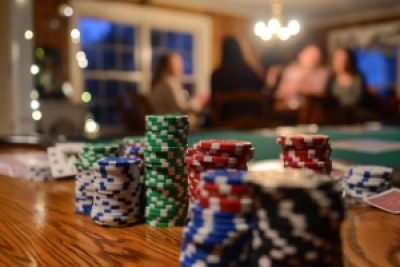Bluffing holds a pivotal role in a poker strategy, serving as a powerful tool to influence outcomes beyond the inherent strength of one's hand. Its significance lies in the capacity to add an element of unpredictability to a player's gameplay, making it challenging for opponents to accurately gauge the strength of their holdings. While not essential in every hand, a well-timed and calculated bluff can enable a player to win pots they would otherwise forfeit, contributing to a more dynamic and successful overall strategy. Balancing the frequency of bluffs, adapting to opponents' playing styles, and understanding the nuances of table dynamics are essential aspects of incorporating bluffing effectively into a poker strategy, elevating it from a mere gamble to a skillful art within the game.
Loading...
The Poker Face Myth: Understanding Bluffing in a Modern Game
Sharpen your instincts as we guide you through 'Reading Between the Bets,' offering insights on spotting bluffs at the poker table and gaining a competitive edge.
Table of contents
What is bluffing in poker?
Bluffing is a crucial and strategic element in poker, adding a layer of psychological complexity to the game. It involves making deceptive actions or statements to mislead opponents about the strength of your hand, ultimately aiming to convince them to make suboptimal decisions.
In poker, players receive private cards (hole cards) and share community cards. The objective is to create the best possible hand or to make opponents believe you have a strong hand when you don't. Bluffing is a skillful tactic used to create uncertainty and manipulate opponents into folding better hands or calling with weaker ones.
Key aspects of bluffing in poker include:
Reading Opponents: Successful bluffing often relies on understanding your opponents' playing styles and tendencies. Observing their behavior, betting patterns, and reactions can provide valuable information about their likely hand strength.
Board Texture: Bluffing is often more effective when the community cards present a potential for strong hands. A coordinated board with multiple possibilities for straights, flushes, or high pairs makes it easier to sell the idea that you hold a powerful hand.
Position Matters: Bluffing is generally more effective when you are in a later betting position. Players acting later in a round have more information about opponents' actions, allowing for a more informed decision on whether to bluff.
Consistency: Varying your play is crucial in maintaining the element of surprise. If you only bluff when you have a weak hand, observant opponents may catch on and exploit your strategy.
Bet Sizing: The size of your bets can be a significant bluffing tool. A well-timed and appropriately sized bet can create doubt in your opponents' minds, making them question the strength of their own hands.
Table Image: Your overall reputation at the table influences the success of your bluffs. If you have been playing conservatively and suddenly make a bold move, opponents may be more likely to give you credit for a strong hand.
Timing: Bluffing at the right moment is crucial. Successful bluffs often occur when opponents are more likely to fold due to perceived weakness or uncertainty.
While bluffing is an integral part of poker strategy, it carries inherent risks. If opponents catch on to your bluffing tendencies, they may exploit them, leading to potential losses. The art of bluffing requires a balance of intuition, psychology, and strategic thinking.
Bluffing mistakes in poker
Bluffing is an integral part of poker strategy, but it comes with pitfalls that can lead to costly mistakes. Recognizing and avoiding these common errors is crucial for maintaining a successful bluffing strategy.
One prevalent mistake is overestimating the right moment: Some players get caught up in the idea of making a big bluff and may force the situation rather than patiently waiting for a genuinely opportune moment. This impatience can lead to poorly timed bluffs that are more likely to be detected by observant opponents.
Another common error is neglecting opponents' playing styles: Bluffers often focus on their own tactics without adequately considering the playing styles of their opponents. Failure to adapt to different opponents can result in bluffs being easily called or raised by those who are adept at reading patterns.
Inconsistent bet sizing is another pitfall. Some players reveal the strength of their hand through inconsistent bet sizes. A sudden increase in the size of a bet might signal a bluff, while consistently using the same bet size can also make your bluffs more predictable.
Misreading the board texture is also a common mistake. Bluffing becomes less effective on boards with obvious potential for strong hands. Ignoring the community cards and their implications can lead to unsuccessful bluffs against opponents holding genuine strength.
A lack of awareness of table image is a significant error. Failing to recognize how others perceive your playing style can impact the success of your bluffs. If opponents have labeled you as a frequent bluffer, they are more likely to call or re-raise.
Lastly, ignoring positional considerations can lead to ineffective bluffs. Bluffing from an early position gives opponents more information to make informed decisions, diminishing the effectiveness of the bluff. Understanding the significance of position is crucial for executing successful bluffs.
Art of bluff timing
Timing in bluffing is an intricate aspect of poker strategy, demanding a keen awareness of various factors to execute successfully. Observing opponents' patterns is fundamental, discerning moments when players exhibit signs of vulnerability or hesitation. Table dynamics, encompassing relationships between players and the overall atmosphere, play a pivotal role. Tensions and conservative decision-making can create favorable conditions for a well-timed bluff.
Positional awareness is crucial in determining when to bluff, with a later betting position providing more information about opponents' potential hands. Reading the board is equally important; a favorable texture or potential draws can enhance the effectiveness of a bluff. Player image, cultivated through prior gameplay, influences opponents' expectations and reactions to a bluff. Adapting to changing circumstances and remaining flexible in strategy is vital, considering shifts in the dynamics of the game.
Consideration of stack sizes, both yours and your opponents', is integral. Bluffing gains potency when opponents have smaller stacks, as they may be less willing to risk a significant portion of their chips. Patience is a key component, emphasizing the importance of waiting for the opportune moment rather than impulsively forcing a bluff. Mastering the art of timing requires a deep understanding of the game, opponents, and the ever-evolving dynamics at the poker table, honed through experience and careful observation.
Shrewd Tip
The most crucial tip for bluffing in poker is to ensure that your bluffs tell a cohesive and believable story within the context of the hand. Your actions and betting patterns should align with the narrative you're presenting to your opponents.
How to tell when someone is bluffing in poker
Reading your opponents' bluffs in poker is a skill that involves analyzing their behavior, betting patterns, and other cues to make an informed guess about the strength of their hand. It's a combination of observation, intuition, and understanding psychological signals. Here are key elements to consider when trying to read your opponents' bluffs:
1. Betting Patterns: Pay attention to your opponents' consistent betting behaviors. Sudden changes in their betting patterns, such as an unusually large bet or a series of aggressive actions, may signal an attempt to bluff.
2. Timing of Bets: The timing of bets can be revealing. Quick bets or snap calls may indicate confidence, while hesitations or lengthy deliberations might suggest uncertainty or an attempt to appear strong.
3. Body Language: Non-verbal cues, such as body language and facial expressions, can offer valuable insights. Look for signs of nervousness, like fidgeting or changes in posture, which may betray a weak hand.
4. Eye Contact: Eye contact can be a telling sign. Some players maintain strong eye contact to convey confidence, while others might avoid it when bluffing to avoid giving away their intentions.
5. Speech Patterns: Verbal communication can provide hints. Pay attention to changes in tone, speed, or choice of words. Nervousness or inconsistencies in their speech may indicate a bluff.
6. Table Talk: Conversations at the table can be revealing. Some players engage in conversation to divert attention or create a false sense of security, while others may become more reserved during a bluff.
7. Previous Hands: Consider your opponents' actions in previous hands. If they've recently shown down a strong hand, they might be more inclined to bluff in the current hand.
8. Player Image: Take into account the overall image your opponents have cultivated at the table. A player known for aggressive play may bluff more frequently, while a tight player's bluff might be more significant when it occurs.
9. Position: Consider the player's position in the betting order. Bluffing is more common from later positions, where there is more information available about opponents' actions.
10. Board Texture: Analyze the community cards on the board. A coordinated board with potential draws might be an ideal setting for a bluff, as your opponent may assume you have a strong hand.
Successfully reading your opponents' bluffs requires a combination of these factors and a continuous process of observation and adaptation throughout the game. It's an essential skill that can significantly impact your decision-making and overall success at the poker table.
Bluffing at online poker
Bluffing in online poker introduces unique dynamics compared to traditional brick-and-mortar games, and understanding these nuances is crucial for success. One significant aspect is the absence of physical tells, making reliance on behavioral cues impossible. Instead, players must focus on digital cues, such as the speed of bets and the timing of actions.
The pace of online poker is generally faster, requiring players to adapt and make decisions promptly. Consequently, well-timed bluffs in online play can catch opponents off guard, capitalizing on the rapid flow of the game. Conversely, the absence of physical presence means players lose the ability to observe opponents directly, emphasizing the importance of statistical analysis and pattern recognition.
Online poker platforms often provide a wealth of data, including players' historical hands and statistics. Successful online bluffing involves leveraging this information, understanding opponents' tendencies, and exploiting their weaknesses. Smart use of technology, including HUDs (Heads-Up Displays) that display relevant player stats, can be invaluable in shaping effective bluffing strategies.
Moreover, the virtual setting allows for multi-tabling, a practice where players participate in multiple games simultaneously. This introduces the challenge of managing bluffs across various tables, requiring a higher level of strategic thinking and adaptability. Recognizing when to employ a bluff becomes even more critical in a fast-paced and multi-table environment.
However, the digital nature of online poker also presents risks, as opponents may use software tools to track and analyze player behavior. This underscores the importance of unpredictability in bluffing strategies. Online players should vary their playstyle to avoid becoming too predictable and exploit the tendencies of opponents who rely excessively on tracking software.







